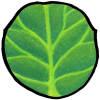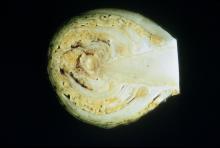Maturity and Quality
Brussels sprouts are the compact vegetative buds that develop along the stem of the Brussels sprouts plant. They should be harvested when the buds are firm, but not overmature which is indicated by splitting of the outer leaves.
Good quality Brussels sprouts should be bright green, without yellowing or discoloration, and have a firm texture. The butt end may be slightly discolored, but should not be dark. Brussels sprouts should be sweet and mild in flavor when cooked. Bitterness varies among cultivars and is associated with high concentrations of specific glucosinolates (sinigrin and progoitrin). Bitterness can also be induced by storage conditions (see Responses to Controlled Atmospheres).
Postharvest Handling and Storage
Brussels sprouts are moderately perishable and can be stored 3-5 weeks at temperatures near the optimum of 0°C (32°F). Shelf life at 5°C (41°F) is 10-18 days and at 10°C (50°F) is less than 7 days. Brussels sprouts are often hydrocooled, but can be air cooled as well. Although they have considerable wax on their leaves, they become flaccid due to water loss if high relative humidity is not maintained.
Freezing Injury. Brussels sprouts freeze at about -0.6°C (30.9°F). Slight freeze damage on the outer leaves of buds may result in small dark and translucent areas. Severe freeze damage results in the entire bud becoming dark and translucent, and very soft after thawing.
Brussels sprouts have relatively high respiration rates. The highest rate at each temperature corresponds to measurements within 1-2 days of harvest.
| Temperature | 0°C (32°F) | 5°C (41°F) | 10°C (50°F) | 15°C (59°F) | 20°C (68°F) |
| ml CO2/kg·hr | 5-15 | 11-24 | 20-40 | 30-50 | 45-75 |
To calculate heat production, multiply ml CO2/kg·hr by 440 to get BTU/ton/day or by 122 to get kcal/metric ton-day.
Brussels sprouts are sensitive to exposure to ethylene. Leaf yellowing and leaf abscission are the most common symptoms of ethylene injury.
>95%
Ethylene production rates are slightly higher than those of other green and leafy vegetables, but can still be classified as low:
Brussels sprouts can be benefited by 1-4% O2 with 5-10% CO2 atmospheres at 2.5-5°C (32-41°F). The main benefits are reduced yellowing and decay, reduced butt discoloration and inhibition of ethylene production. No benefits of CA are observed if the Brussels sprouts are kept at their optimum storage temperature 0°C (32°F). Low oxygen storage (<1%) can cause extreme bitterness and may also cause internal discoloration. Atmospheres of 10-12% CO2 can result in off-flavors and off-odors.
Disorders
Freezing Injury. Brussels sprouts freeze at about -0.6°C (30.9°F). Slight freeze damage on the outer leaves of buds may result in small dark and translucent areas. Severe freeze damage results in the entire bud becoming dark and translucent, and very soft after thawing.
Puffiness. Or lack of firmness is undesirable in the buds and may vary among cultivars and growing conditions.
Internal browning. Can occur under very wet production conditions and is associated with condensation on the developing leaves.
Physical Injury. Rough handling at harvest can bruise the buds and increase decay.
Brussels sprouts are not very prone to postharvest decay, but may be affected by the same organisms that infect other Brassica vegetables. Bacterial decay due to various soft-rot causing organisms (Erwinia, Pseudomonas) may infect sprouts, but bacterial decay is usually associated with physical injury. Less common are fungal pathogens, which can occur under rainy and cool growing conditions.




